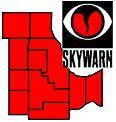

Report these observations to your local Skywarn net control. He/she will determine if it warrants passing the report on to the National Weather Service.
| TORNADO | |
|---|---|
| WATERSPOUT | |
| FUNNEL CLOUD |
Organized, persistent, sustained rotation |
| WALL CLOUD |
Organized, persistent, sustained rotation |
| HAIL |
Nickel size or larger. Report the largest size hailstone |
| WIND GUSTS |
40 mph or higher. Specify estimate or measurement |
| FLOODING |
Flooding that impacts roads, homes or businesses. |
| RAIN |
1/4 inch or more within a 15 minute period. |
| STORM DAMAGE |
Damage to structures (roof, siding, windows, etc) |
| HEAVY SNOW |
1" or more per hour, accumulations of 2" or more |
| ICE JAMS |
Ice jams on rivers or streams |
Again, reports should provide as much detail as possible to describe the where, when, how, etc of the event.
| Pea | .25 inch | Golf Ball | 1.75 inch |
|---|---|---|---|
| Half-inch | .50 inch | Hen Egg | 2.00 inch |
| Dime | .75 inch | Tennis Ball | 2.50 inch |
| Nickel | .88 inch | Baseball | 2.75 inch |
| Quarter | 1.00 inch | Tea Cup | 3.00 inch |
| Half Dollar | 1.25 inch | Grapefruit | 4.00 inch |
| Ping Pong Ball | 1.50 inch | Softball | 4.50 inch |
| 30-44 mph (26-39 kt) | Whole trees in motion. Inconvenient walking into the wind. Light-weight loose objects (e.g., lawn furniture) tossed or toppled. |
|---|---|
| 45-57 mph (39-49 kt) | Large trees bend; twigs, small limbs break and a few larger dead or weak branches may break. Old/weak structures (e.g., sheds, barns) may sustain minor damage (roof, doors). Buildings partially under construction may be damaged. A few loose shingles removed from houses. |
| 58-74 mph (50-64 kt) | Large limbs break; shallow rooted trees pushed over. Semi-trucks overturned. More significant damage to old/weak structures. Shingles, awnings removed from houses; damage to chimneys and antennas. |
| 75-89 mph (65-77 kt) | Widespread damage to trees with large limbs down or trees broken/uprooted. Mobile homes may be pushed off foundation or overturned. Roof may be partially peeled off industrial/commercial/ warehouse buildings. Some minor roof damage to homes. Weak structures (e.g., farm buildings, airplane hangars) may be severely damaged. |
| 90+ mph (78+ kt) | Many large trees broken and uprooted. Mobile homes damaged. Roofs partially peeled off homes and buildings. Moving automobiles pushed off the road. Barns, sheds demolished. |